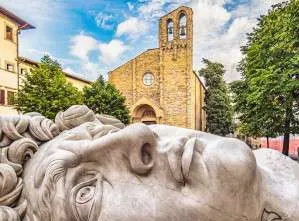The Basilica of St. Dominic, a tribute to the founder of the Dominicans, is a landmark of great beauty and significance for the city.
The Roots and Architecture of the Basilica of St. Dominic
Rising majestically in the square that bears its name in Arezzo, the Basilica of San Domenico sports a distinctive asymmetrical facade. Founded by Dominican friars around 1240, construction, which included a convent, continued until the early 14th century. The construction was strongly supported by the Ubertini and Tarlati families of Arezzo, helping to bring the structure to life. Architecturally, the basilica bears similarities to the Basilica of Santa Maria Novella in Florence.
Cultural and Artistic Importance
During the 14th and early 15th centuries, the interior walls of the basilica were the focus of the local school of painting, influenced by Sienese and Florentine models, but with its own characteristics. The Basilica of San Domenico has witnessed a blend of styles and influences that have marked Arezzo over the centuries, becoming a place where art and faith come together, representing the city’s cultural heritage. Moreover, in 1276 the basilica hosted the first Conclave in the history of the Church of Rome.
The Historical Challenges
Despite its historical prominence, the Basilica was not immune to historical changes. In 1782 it was decommissioned due to a reform of religious orders in the Grand Duchy of Tuscany, remaining unused until the 20th century.
Where is the Basilica of St. Dominic
The Basilica of San Dominic in Arezzo is located a short distance from the historic centre, specifically in Piazza San Domenico. Known for its simple brick façade and for housing Cimabue’s Crucifix, this church is immersed in a charming setting, with enchanting views over the city’s rooftops and a peaceful atmosphere. The surrounding area includes medieval alleyways, small gardens and some characteristic bars and restaurants where you can stop for a coffee or a typical meal. From the B&B Cento Passi dal Duomo, the basilica is easily reachable with a short walk, offering guests the opportunity to explore another artistic jewel of Arezzo.
The Interior Beauty of the Basilica of St. Dominic
Inside, the Basilica astonishes with its beauty. Twelve Gothic windows illuminate the only corridor, decorated with frescoes and paintings from the 14th century. On the counterfaçade, two Renaissance works from Arezzo catch the eye: on the one hand, “Saints Philip and James Minor and Stories of Their Lives and St. Catherine” by Spinello Aretino, on the other “The Crucifixion between the Virgin, St. Nicholas, St. John and St. Dominic” by Parri di Spinello.
Significant Works and Beato Angelico’s Funerary Monument
The basilica houses significant works of art, such as the Crucifix of St. Dominic by Cimabue, a masterpiece that preludes the Renaissance style. It also houses the funerary monument of Blessed Angelico, made by Andrea della Robbia. Other works of art present include such important sculptures as the Gothic altar by Giovanni di Francesco da Firenze and glazed terracottas by della Robbia.
Unesco Recognition
In 1998, the Basilica was declared a UNESCO World Heritage Site as part of Arezzo’s historical and artistic heritage, along with Piazza Grande and the Cathedral of San Donato.
Basilica of San Dominic : An Essential Visit
The Basilica of St. Dominic is a must-see destination for those visiting Arezzo, representing an outstanding example of Tuscan Gothic art and architecture. Its historical and artistic importance makes it one of the most celebrated tourist destinations.
Explore Arezzo with Cento Passi dal Duomo
The Basilica is just the beginning of the historical and artistic wonders that surround the B&B Cento Passi Dal Duomo in Arezzo. Continue to discover other must-see destinations on our site, such as the Cathedral of Saints Peter and Donato, the Ivan Bruschi House Museum and the Birthplace of Francesco Petrarca. Cento Passi dal Duomo awaits you for an unforgettable experience.
Photo courtesy of Arezzo photographer Raul Dominici.

